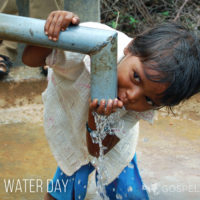 What if every day you turned on your faucet and risked becoming seriously ill from drinking the water?
What if every day you turned on your faucet and risked becoming seriously ill from drinking the water?
That is a question posed on the website of Water for Thirty Thousand. It is a question that needs to be asked of all of use in the Western world.
We take water for granted whether it comes from our taps, from bottles, or dispensers on our refrigerator door. It’s not just that we take water for granted; we take clean water for granted. We take it for granted that there is plenty of it and that is available whenever we want it.
We fail to realize that every glass of water is a potential killer. This is especially true in developing countries in Africa and South Asia.
According to The Water Project,
In developing countries, about 80% of illnesses are linked to poor water and sanitation conditions.
One out of every five deaths under the age of five worldwide is due to a water-related disease.
You may find it easy to believe the clean water crisis in the least developed countries. You may even realize that the problem of access to clean water is a problem. But you may not realize that it is more than an inconvenience. It is deadly.
And it is not limited to the least developed. It is also a deadly problem within the fastest growing of those countries, even where technology is highly advanced.
The World Health Organization Water Fact Sheet these startling statistics”
Globally, at least two billion people use a drinking water source contaminated with feces.
842,000 people are estimated to die each year from diarrhea because of unsafe drinking-water, sanitation, and hand hygiene.
Almost 240 million people are affected by schistosomiasis – an acute and chronic disease caused by parasitic worms contracted through exposure to infested water.
As our calendars move from March and World Water Day, we find ourselves in April and World Health Day (April 7th). Daily at Gospel for Asia, we see how closely linked clean water and health are related. Unfortunately, we realize it because what we see is how people are chronically and often deathly sick due to using contaminated water.
Although there may be cases where a few people may have limited awareness of the danger of dirty water, the greater problem is that the majority who use contaminated water have access to nothing else.
30,000 South Asians die from unsafe water each year just in Karachi, the largest city in Pakistan.
Reporters from China News Daily watched a Nepal woman wash her rice in the water she had trekked miles to gather. As she “washed” the rice, it turned black from the contamination in the water.
6,000 rivers flow through Nepal – but none of those in the Kathmandu Valley, the most developed and populated place in Nepal, are clean. The four million residents there use around 320 million liters of water every day. The government, however, can only meet 20 percent of that demand.
That last statistic helps to explain why even countries experiencing rapid economic and population growth still have major health issues due to unsafe water.
It costs a lot of money to provide safe water for large and dispersed populations. And significant additional funds are necessary to complete the sanitation cycle by providing adequate sanitation facilities that protect water sources from contamination.
Developing countries face a clean water Catch-22. “Which do we build first – GDP or infrastructure?” On the one hand, building the GDP first generates capital that can be used to fund clean water and sanitation projects. On the other hand, building infrastructure first results in a healthy and available workforce. Obviously, this is not a one or the other kind of choice. It is a matter of establishing priorities within the context of each situation.
The task at hand is monumental.
Almost two billion people use a source of drinking water contaminated with feces, putting them at the risk of contracting cholera, dysentery, typhoid and polio
Contaminated drinking water is estimated to cause more than 500,000 diarrheal deaths each year and is a major factor in several neglected tropical diseases, including intestinal worms, schistosomiasis, and trachoma, according to WHO.
35% of people in South East Asia use a source of drinking water contaminated with feces (about 630 million people).
The task is so monumental that governments alone cannot address the need without assistance. That is why numerous NGOs, many of them faith-based like Gospel for Asia (GFA), focus so much attention on providing clean water and improving sanitation. We extend our help by demonstrating the life-giving love of Christ to help those who cannot help themselves.
There is no single entity that can provide all the resources needed to create a healthier world with cleaner water. But we can have compassion and demonstrate it by helping those we can with what we have.
We would ask you to consider partnering with us to provide Jesus Wells and BioSand filters for families and communities with whom we have a contact in South Asia. Together, we can bring the water of life to people who desperately need it.
Sources:
- The Water Project, Health and Water
- WHO International, Drinking water fact sheet
- All About Water Filters, 21 Disturbing Truths About Asia’s Water Pollution Problem
- Channel News Asia, In the land of 6,000 rivers, a contamination crisis: Nepal’s water nightmare
- Hindustan Times, 630 million people in India, SE Asia using water from feces-contaminated sources: WHO
- Water for Thirty Thousand website
For more information about this, click here.




